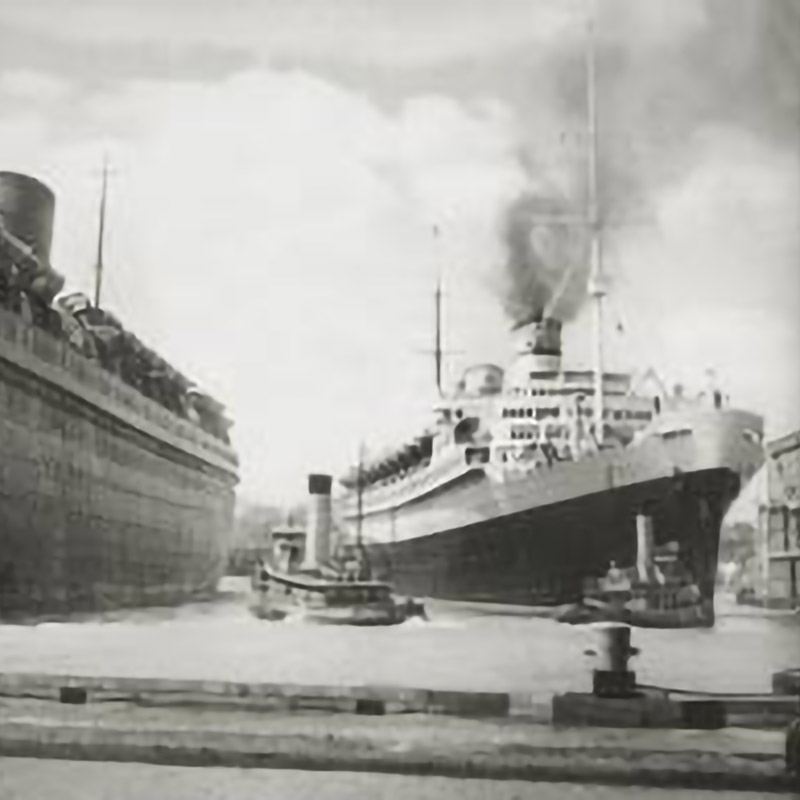Album di famiglia n.3
To complete the splendid documentation
of the family who lived in the Boschi Di Stefano House-Museum in Milan comes, after No. 1 and No. 2, a final Family Album No. 3. This third notebook adds an unpublished account of their travels to the daily life (no. 1) and leisure time (no. 2) of an unusual upper middle-class Lombard couple. We are in the first half of the last century, the characters are curious, cultured and well-to-do, still among the few who could afford such daring tourism (for example to the Middle East and Northern Europe), but they are also careful to document it as an enriching and memorable moment of life. The photographic instrument, although used in an amateurish style, proves to be perfect in confirming the experiences and delightful in the memory of the protagonists (and for us also of their era).
Among the many cues offered by the photographs selected here, we like to emphasise the places where the couple travels, the means of transport they use, the outfits they wear for their journeys, but also the individual perspectives chosen for the photographic shots, often curious and ironic, or amazed and almost incredulous at the reality they are framing. The main locations of Marieda Di Stefano and Antonio Boschi’s travels – as has already been mentioned – are the lands of the Middle East (Egypt in particular) and those lapped by a cruise in the seas of Northern Europe. The former retrace itineraries that many ‘young adventurers’ had chosen, as early as the mid-nineteenth century, to broaden the European horizon of the previous, classic Grands Tours to the ancient cultures of Egypt, Arabia and the Fertile Crescent. Among many, it was the 1865 journey of the Lombard marquis and naturalist Giammartino Arconati Visconti to Arabia Petrea. (I viaggi di Giammartino Arconati Visconti, edited by Maria Cristina Antonini Berti, 2009).
The cold lands of Northern Europe, on the other hand, are a sort of new discovery for the Milanese couple of the 20th century, perhaps a challenge of confrontation with landscapes and climates no less difficult than those of the Middle East, but just as rich in fascination and wonder. Before that trip, there are other trips to Berlin and Brussels. Also exceptional for the time was a trip to Japan.


Steamship navigation is chosen for all the most demanding journeys. It sometimes offers marvels beyond imagination, as evidenced, for example, by the photograph of the Corinth Canal, taken from the quarterdeck of the steamer Stella d’Italia carrying our luxury tourists. No less significant is Marieda’s gaze from the deck of a ship on the open sea (we don’t know which one), against the wind ruffling her hair, as rough waters offer themselves before her in all their breadth. It is also amusing to trace the era of those voyages through the clothes and hats of the travellers.
The men’s and all the winter ones are not much different from the current ones, but the summer dresses of Marieda and her friends deserve a mention. They are light, fluffy, but absolutely ‘costumed’, usually cover the legs and do not fail to be accompanied by appropriate hats: small in winter, wide and very light in summer. The swimming costumes are one-piece for women, but also for men. Truly costumes from another era! In addition to these cues, related to the locations visited around the world, the means of reaching them and the clothing used, many of the shots chosen by our protagonists for their travel memories are interesting. Inevitable, and less fascinating, are the somewhat static poses in front of the lens. The snapshots, on the other hand, are very effective, from the one in the streets of Brussels, to the one of Marieda with her donkey in Athens, to the one of the games in the swimming pool of the steamer Stella d’Italia in 1932, or the one of the couple with various friends during the same cruise. Even Antonio seems taken by surprise on the deck of the ocean liner Rex, which had recently won the Blue Riband of the Atlantic crossing.
In front of the pyramid of Chephren and the sphinx, however, it is difficult for Marieda not to pose. This seems almost fatal for all the photographs of the trip to Egypt: splendid documentations, moreover, of monuments that were then so little known. Curious and ironic, on the other hand, are the portraits of Marieda almost posing in imitation of ancient statues and the photos of the outing with the donkey in ancient Thebes. Marieda’s climb to the shrouds of the steamer Pilsna in November 1934 also appears singular, as does, even for much more modern times, the visit of ours to the Feroe Islands and especially the Spitsbergen: Marieda caressing the large antlers of an elk is perhaps the most beautiful memory of that trip.
Of the excursion to Japan, unfortunately only this image of the couple in kimono remains to us, but the faces of ours seem happy and interested in the novelty of the country they are visiting, as they often appear in all their wanderings of world discovery. Marieda and Antonio have certainly explored the world for a pleasure permitted by their social, professional and cultural status, but through these photographs they show that they have always done so with curiosity and respect for all that is different: it seems a simple but beautiful lesson for so many tourists today.
Giacomo Corna Pellegrini
